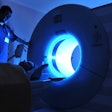About half of medical imaging equipment service calls are not fully resolved on the first visit, according to a new report.
Analysis of anonymized data by agentic AI software developer Aquant tracked 14 medical imaging service organizations and 6,500 technicians running almost 2 million service events on nearly 300,000 assets. For medical equipment service and repair organizations, the firm's 2025 Service Benchmark Report: Medical Device Edition aims to provide benchmarks across five key performance indicators:
- First-time fix rate measured across 30 days
- Issue resolution time between case creation and closure dates
- Average number of days between service visits
- Percentage of assets that require an additional service event within three months of a completed preventative maintenance visit
- Percentage of service events where more than one part is replaced to resolve an issue
"Our benchmark report is designed for service organizations and what their top and bottom line look like," Edwin Pahk, Aquant's senior vice president of presales and customer success, told AuntMinnie. “The data from the 14 imaging service organizations reflects actual performance from those specific contributors -- it’s not extrapolated to represent the entire imaging equipment service market. While not comprehensive, these are leading organizations in the industry and represent a significant share of the market, providing a strong directional insight into industry trends.”
Medical imaging service events refer to on-site visits by field service technicians to repair medical imaging equipment, Pahk continued. "These events are typically triggered by a service request from a healthcare facility when an issue can't be resolved remotely."
Assets are the MRI, x-ray machines, or another medical imaging devices being serviced.
"While some problems may initially be assessed by call center agents, the service event itself involves a technician physically going to the location to diagnose and fix the issue," Pahk said.
The service benchmark report suggested that organizations that integrate AI for their service technicians experience 39% faster resolution times and less downtime, and 121% higher accuracy in service troubleshooting.
"A lot of our customers are focused on this concept of first-time fix rate," Pahk explained. "In imaging specifically, the first-time fix rate is around 60%, which means that 60% of the time, when a technician goes onsite to fix an imaging machine, 6 out of 10 times they will be able to fix that problem on the spot. But 4 out of 10 times, they may have to come back out, for a variety of different reasons."
Key findings from the report include the following:
 First-time fix rate for medical imaging equipment service calls as reported in the 2025 Service Benchmark Report: Medical Device Edition.
First-time fix rate for medical imaging equipment service calls as reported in the 2025 Service Benchmark Report: Medical Device Edition.
- Imaging equipment service resolves only 51% of issues on the first visit for bottom-performing companies, while top performers achieve 79%.
- Resolution times range from three days for the best operators to 13 days for bottom performers, meaning some hospitals wait four times longer for critical imaging equipment repairs, according to the report.
- Bottom-tier service organizations require service every 29 days, compared to 99 days for top performers who keep machines running longer.
- A failed first visit increases service costs by 87% per work order and adds 12 days to the resolution time, making it critical for imaging service providers to improve first time-fix rates and predictive maintenance strategies, according to the report.
"Some of the problems are difficult problems to solve ... the pool of labor in this market is only getting smaller, and it is a big problem and a big stressor for not only the manufacturers of these machines, and independent service providers, but also hospital groups," Pahk noted.
AI-driven service models, predictive analytics, and remote triage will improve first-time fix rate, reduce unnecessary second visits, and lower hospital service costs, according to the report.
"Service used to purely be troubleshooting and triaging," Pahk added. "That was where we saw a major value proposition, where AI could help throughout the service life cycle. With AI-powered service tools, technicians are better equipped to resolve problems on the first visit, making repairs faster, more accurate, and cost-effective.”




















